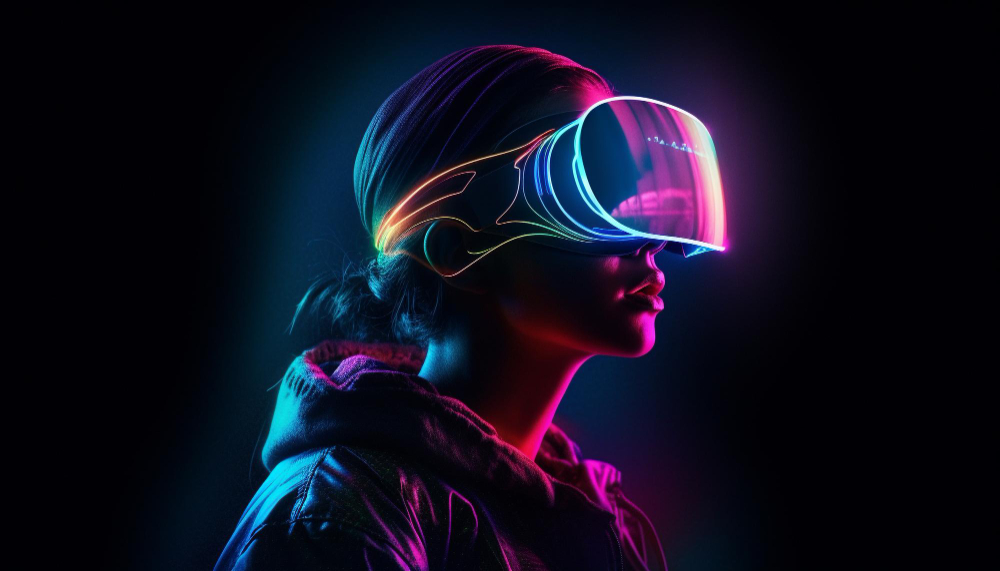The gaming industry is no stranger to technological breakthroughs, with each advancement promising a more immersive and captivating gaming experience. The latest spotlight on AI-generated game assets represents a significant leap forward. In recent years, developers have harnessed the power of AI-driven game asset generators to create a collaboration between creativity and efficiency. The result is a gaming landscape that boasts not only stunning visual elements but also immersive gaming experiences that keep players coming back for more.
As we delve deeper into this new era of AI-generated game assets, the boundaries of the possibilities of gaming continue to expand, promising an exciting future for gamers and developers alike.
AI-Generated Game Assets in Game Development:
Historically, the process of creating game assets has been a time consuming and labor-intensive affair, demanding considerable effort, and resources. Teams of skilled artists and designers worked meticulously to craft each component. However, AI-powered game asset generators have disrupted this conventional model, offering a transformative solution.
These AI systems employ the principles of machine learning and neural networks, learning from extensive datasets of existing assets to understand the details of design. The result is a streamlined, cost-effective approach to generating game assets, enabling developers to save both time and resources in the process.
Furthermore, the adoption of AI-generated game assets has not only expedited the development process but has also opened up new avenues for creativity and innovation in game design. Game developers can now explore novel and experimental concepts with relative ease, as AI systems can swiftly generate a wide range of assets, from character models and textures to environmental elements. This creative freedom allows for more diverse and engaging gaming experiences, enabling developers to push the boundaries of what’s achievable in the virtual worlds they create.
The Impact of AI-Generated Game Assets
The influence of AI-generated game assets is far-reaching, covering various aspects of game development. Here are some key areas where AI is having a profound impact:
1. Character Design:
Character design has always been a prime component of storytelling in video games, and AI has brought a revolution to this aspect. Not only does AI streamline the character creation process, but it also has the potential to adapt characters based on player interactions, creating a dynamic and personalized gaming experience. With AI, character design is not merely a time-saving tool; it’s a tool for engaging narratives and more immersive gameplay.
2. Textures and Environments:
Moreover, AI’s impact on the gaming industry doesn’t stop at character design. It extends to textures and environments, where AI’s abilities shine. By generating detailed textures and environmental assets, AI elevates the visual and atmospheric aspects of game worlds. This advancement is particularly beneficial for open-world games, where the creation of diverse environments, enticing landscapes, and lifelike elements can be challenging without AI’s assistance. With AI, game environments come alive with a level of detail and diversity that was once unimaginable, providing players with an even more captivating gaming experience.
3. Soundscapes:
In addition, AI’s role in gaming doesn’t stop at visuals; it extends its influence into the audio of the game. By generating appropriate soundscapes and music, AI enhances the immersive qualities of a game, creating environments that are not only visually stunning but also acoustically rich. This dynamic approach to audio design contributes to a more emotionally resonant gaming experience, where music and soundscapes adapt in real-time to the player’s actions, intensifying the overall engagement. Whether it’s the rustling of leaves in a forest or the sounds of an intense battle, AI ensures that the auditory experience is as compelling as the visual one, drawing players deeper into the game’s world.
4. Procedural Generation:
Furthermore, the impact of AI in gaming extends to procedural generation, where AI-driven techniques empower developers to create an extensive range of in-game content. This encompasses everything from levels and quests to items and even entire worlds. The dynamic nature of procedural generation ensures that no two gaming experiences are the same, keeping gameplay fresh and full of surprises for players. AI’s ability to generate content on-the-fly adds a layer of variety, providing players with a continuously evolving gaming landscape to explore.
5. Quality Assurance:
Quality assurance is a critical aspect of game development, and AI plays a pivotal role in this area. AI can meticulously scan the game environment to identify bugs, glitches, and inconsistencies that might escape human detection. It not only points out issues but can also take corrective actions, streamlining the debugging process. This detailed and automated quality assurance ensures a smoother and more polished gaming experience, minimizing disruptions and frustrations for players. With AI’s watchful eye, games are not only more enjoyable but also more dependable, leaving players to immerse themselves in the game world without obstructions.

Advantages of AI-Generated Game Assets
The adoption of AI-generated game assets brings a list of advantages to both developers and players:
1. AI- Generated Game Assets Ensure Efficiency:
Efficiency is one of the prime advantages offered by AI-generated game assets. By harnessing the power of AI, game development becomes significantly faster and more cost-effective. AI can generate a vast array of assets in a fraction of the time it would take human artists to produce the same quantity. This efficiency not only speeds up the development process but also reduces production costs, making game development more accessible and enabling developers to allocate resources to other crucial aspects of the game.
2. AI-Generated Game Assets and Creativity:
The adoption of AI-generated game assets offers developers a more creative freedom. With AI handling asset generation, developers can explore unique and diverse assets that might have been too time-consuming or resource-intensive to pursue manually. This flexibility pushes the boundaries of game design, allowing developers to experiment with innovative ideas, create richer and more engaging gaming experiences, and push the limits of what’s achievable in the world of gaming.
3. AI-Generated Game Assets Offer Consistency:
Consistency is another hallmark benefit of AI-generated game assets. AI excels at maintaining a uniform style and quality throughout a game’s assets, minimizing the risk of visual differences within the game world. Unlike human artists who may introduce subtle variations in style and quality, AI uses a predefined set of parameters, ensuring that all assets align seamlessly with the desired aesthetic. This commitment to consistency results in a more visually pleasing gaming experience, where every element of the game world feels uniform, enhancing player immersion and engagement.
4. AI-Generated Game Assets and Scalability:
Scalability is another significant advantage offered by AI-generated game assets. Games can seamlessly expand to accommodate larger worlds or incorporate additional content, all made possible by AI’s ability to generate assets at scale. As the demand for more extensive game environments or additional features arises, AI can quickly produce the required assets, sparing developers from the time-consuming task of manual creation. This scalability not only ensures that games can grow in scope but also provides players with more expansive and dynamic gaming experiences. AI’s contribution to scalability is significant in meeting the ever-evolving demands of the gaming industry.
5. Dynamic Gameplay with AI-Generated Game Assets:
Dynamic gameplay is a key outcome of AI-generated game assets. Procedural generation, underpinned by AI, breathes life into games by constantly introducing new elements and variations. This dynamic approach keeps gameplay fresh and engaging, ensuring that no two games are identical. AI’s role in shaping dynamic gameplay is a tool for player involvement, creating an environment where surprises and challenges await around every corner, enriching the gaming experience and ensuring it remains captivating over time.
The Future of AI-Generated Game Assets
The future of AI-generated game assets holds promise with increasingly remarkable innovations. As AI technology advances, developers will undoubtedly refine and enhance their algorithms, resulting in assets that are not only more realistic and diverse but also tailored to the specific needs and creative visions of each game.
One of the most exciting prospects is the collaboration between AI-generated game assets and emerging technologies such as virtual reality (VR) and augmented reality (AR). As VR and AR games gain momentum, AI-generated content will play a pivotal role in creating immersive experiences that blur the lines between the virtual and real worlds. Here’s how:
1. Immersive Worlds:
Firstly, VR and AR games thrive on immersion, and AI-generated assets will be instrumental in creating highly detailed, lifelike virtual environments. Players will be able to explore worlds that feel almost indistinguishable from reality, thanks to AI’s ability to generate convincing textures, landscapes, and interactive elements.
2. Adaptive Storytelling:
Secondly, AI-generated characters and narratives will adapt to the player’s actions and choices, making the storytelling experience more dynamic and engaging in VR and AR environments. This dynamic storytelling could lead to a deeper sense of player agency, allowing individuals to craft their own unique gaming narratives.
3. Real-Time Interactivity:
Additionally, AI can enhance the interactivity of VR and AR games by generating responsive, dynamic elements. Whether it’s creating realistic weather patterns, simulating the behavior of virtual creatures, or adjusting gameplay challenges in real-time, AI-generated assets will make these experiences feel more alive and interactive.
4. User-Generated Content:
Furthermore, AI can assist players in creating their own game content, from designing characters to crafting levels. This user-generated content could be seamlessly integrated into the virtual and augmented reality worlds, extending the longevity and creativity of these games.
5. Accessibility and Inclusivity:
Lastly, AI-generated game assets can be customized to accommodate various player preferences and needs, making VR and AR gaming more accessible and inclusive. This includes features such as voice commands, personalized avatars, and tailored difficulty levels.
To sum up, the collaboration between AI-generated game assets and VR/AR technologies represents a groundbreaking shift in the gaming industry. It has the potential to redefine how we perceive and interact with virtual and augmented reality spaces, offering players experiences that are not just immersive but also highly personalized and adaptive.

Conclusion
The development of AI-generated game assets is revolutionizing the way we experience our favorite video games, offering not only a game-changer for developers but also delivering richer, more creative, and dynamically evolving game worlds, ensuring that the future of gaming is filled with innovation and immersive experiences. As AI technology continues to evolve and integrate with emerging technologies, we can anticipate a new era of gaming that goes beyond traditional screens and controllers, blurring the lines between the virtual and the real world, redefining how we interact with and enjoy our digital entertainment. In this ever-evolving landscape, AI-driven game assets hold the potential to shape a future where gaming becomes more interesting. So, stay connected with the latest developments and be ready to embark on this thrilling era of gaming innovation. Join the revolution, follow industry updates, and be part of the exciting evolution in gaming experiences!



